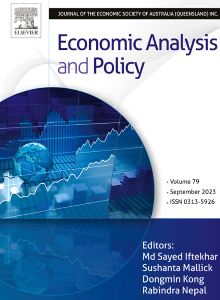公众信任与央行沟通的动态互动
IF 8.7
2区 经济学
Q1 ECONOMICS
引用次数: 0
摘要
中央银行的沟通不一定受益于最大的透明度;最优策略取决于公众的信任程度。本文将公众信任纳入基于宏观经济主体的模型(MABM),考察公众信任在央行沟通和央行预期管理策略之间的动态交互作用。个人对中央银行信息的重视程度取决于信任水平,信任水平会根据中央银行过去的行为和声明的一致性进行适应性调整。这种调整反映了一种权衡:过度透明的沟通可能导致信息过载,破坏政策一致性,而透明度不足则会增加央行信息中的噪音。公众的反应,由私人和公共信息共同塑造,传递到最终的政策结果。然后,央行根据政策结果的反馈,自适应地调整其沟通策略。我们的研究结果表明:1)在公众信任高度稳定的时期,增加透明度可以显著减少社会福利损失。ii)当公众信任呈现动态调整特征时,央行应采取自适应沟通策略,即央行根据公众信任水平的波动动态调整其信息透明度,从而实现透明度与政策预期稳定之间的动态均衡的行为逻辑。我们的研究结果表明,通过积极回应公众反馈,实施适应性沟通策略,央行可以不断改善和稳定社会信任,从而扩大政策的操作空间。本文章由计算机程序翻译,如有差异,请以英文原文为准。
Dynamic interaction between public trust and central bank communication
Central bank communication does not necessarily benefit from maximal transparency; the optimal strategy depends on public trust levels. This paper integrates public trust into a Macroeconomic Agent-Based Model (MABM) to examine the dynamic interaction between public trust in central bank communication and central bank expectation management strategies. The importance that individuals attach to central bank information is contingent upon trust levels, which adaptively adjusts based on the consistency of the central bank’s past actions and statements. This adjustment reflects a trade-off: excessively transparent communication can lead to information overload and undermine policy consistency, while insufficient transparency increases noise in central bank information. Public responses, shaped by both private and public information, transmit to the ultimate policy outcomes. The central bank then adaptively adjusts its communication strategy based on the feedback from policy outcomes. Our findings indicate that: i) In periods of high and stable public trust, increasing transparency can significantly reduce social welfare losses. ii) When public trust exhibits dynamic adjustment characteristics, central banks should adopt adaptive communication strategies, which refers to the behavioral logic whereby central banks dynamically adjust their information transparency based on fluctuations in public trust levels, thereby achieving a dynamic equilibrium between transparency and policy expectation stability. Our research results indicate that by actively responding to public feedback and implementing adaptive communication strategies, the central bank can continuously improve and stabilize social trust, thereby expanding the operational space for policies.
求助全文
通过发布文献求助,成功后即可免费获取论文全文。
去求助
来源期刊

Economic Analysis and Policy
ECONOMICS-
CiteScore
9.80
自引率
9.20%
发文量
231
审稿时长
93 days
期刊介绍:
Economic Analysis and Policy (established 1970) publishes articles from all branches of economics with a particular focus on research, theoretical and applied, which has strong policy relevance. The journal also publishes survey articles and empirical replications on key policy issues. Authors are expected to highlight the main insights in a non-technical introduction and in the conclusion.
 求助内容:
求助内容: 应助结果提醒方式:
应助结果提醒方式:


